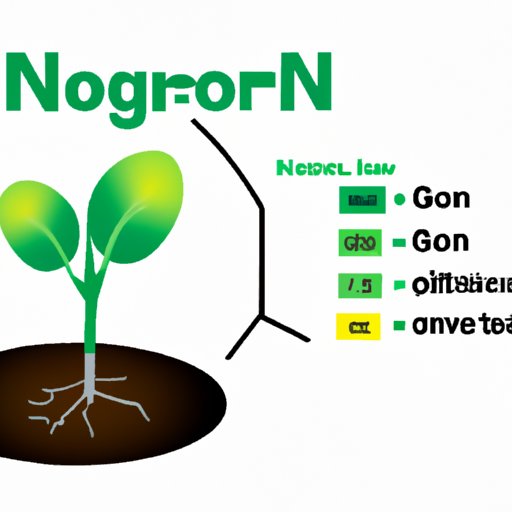Introduction
Plants require essential nutrients to grow and thrive, and one of the most critical elements is nitrogen. Nitrogen plays a vital role in the growth and development of plants, and it is responsible for various physiological and biochemical processes. In this article, we will explore the importance of nitrogen for plant growth, the role of nitrogen in photosynthesis, nutrient deficiencies, fertilizing with nitrogen, nitrogen in the soil, impacts of climate change on nitrogen levels, and the nitrogen cycle in ecosystems. This article is intended for gardeners, horticulturists, or anyone interested in plant growth and development.
The Basics of Nitrogen and Plant Growth
Nitrogen is an essential macronutrient, representing up to three percent of a plant’s total dry weight. Nitrogen is required for building nucleic acids, amino acids, and proteins, which are necessary for plant growth and development. Nitrogen also plays a crucial role in photosynthesis, chlorophyll formation, and stress response.
Plants absorb nitrogen in the form of nitrate (NO3-) or ammonium (NH4+) ions. Nitrate is the preferred form of nitrogen for most plants. Nitrate ions are negatively charged and soluble, which means they can dissolve in water and move freely through the soil towards the roots. Ammonium, on the other hand, is positively charged and binds tightly to soil particles, making it less mobile and harder to absorb.
The Role of Nitrogen in Photosynthesis
Photosynthesis is the process by which plants capture light energy and convert it into chemical energy in the form of sugar. Nitrogen plays a crucial role in photosynthesis because it is a component of chlorophyll, the pigment that gives plants their green color. Chlorophyll molecules absorb light energy, which they use to produce ATP, a molecule used by cells as an energy source. Without sufficient nitrogen, plants cannot produce enough chlorophyll, which leads to reduced photosynthesis and lower productivity.
Plant Nutrient Deficiencies
Plant nutrient deficiencies occur when a plant cannot absorb or use a nutrient essential for its growth and development. Nutrient deficiencies can result in stunted growth, reduced productivity, and sometimes death. Nitrogen deficiency is one of the most common nutrient deficiencies in plants. Symptoms of nitrogen deficiency typically include yellowing of leaves, reduced growth rates, and small fruits or vegetables. Nitrogen deficiencies can often be detected by examining plant tissue or by conducting soil tests.
To prevent nitrogen deficiency, it is essential to maintain adequate soil nitrogen levels. One way to do this is by regularly fertilizing with nitrogen. However, over-fertilization can also cause damage to plants and the environment.
Fertilizing with Nitrogen
Fertilizers are often used to increase soil fertility and promote plant growth. Nitrogen fertilizers come in several forms, including synthetic fertilizers and organic fertilizers. Synthetic fertilizers are made from chemicals, and they are quick-acting, easy to apply, and relatively inexpensive. However, synthetic fertilizers can also pollute groundwater and soil if overused or misapplied.
Organic fertilizers, on the other hand, are made from natural sources, such as compost, manure, or blood meal. Organic fertilizers are slower acting than synthetic fertilizers, but they also provide long-term benefits to soil health and plant growth. Organic fertilizers are less likely to cause pollution, and they are often more sustainable than synthetic fertilizers.
When applying nitrogen fertilizer, it is crucial to follow the recommended amounts carefully. Over-fertilization can cause nitrogen pollution, where excess nitrogen leaches into groundwater or is washed into rivers and lakes through rainwater runoff.
Nitrogen in Soil
Soil type and health play a crucial role in the availability of nitrogen to plants. Sandy soils tend to have low nitrogen levels, while clay soils may have higher nitrogen levels but tend to hold on to nitrogen tightly, making it less available to plants.
Soil nitrogen levels can be managed by adding organic matter to the soil, such as compost or manure. Organic matter can increase soil fertility by adding nutrients to the soil and improving soil structure. Cover crops, like legumes, can also increase soil nitrogen levels by fixing nitrogen from the atmosphere into the soil.
Impacts of Climate Change on Nitrogen Levels
As temperatures rise, nitrogen levels in the soil can change, which can affect plant growth and health. High temperatures can cause soil nitrogen to be released as gas, reducing the amount available to plants. Elevated CO2 levels can also reduce soil nitrogen levels since plants require less nitrogen for photosynthesis in high CO2 environments. These changes can lead to reduced plant growth rates, crop yields, and plant diversity.
To manage nitrogen levels in changing climates, it is essential to monitor the soil regularly and adjust fertilization practices accordingly. Planting more drought-resistant crops or using no-till farming practices can also help retain soil nitrogen levels.
The Nitrogen Cycle in Ecosystems
The nitrogen cycle describes how nitrogen moves through the ecosystem. Nitrogen fixation is the process by which nitrogen is converted into a usable form by bacteria, or through lightning strikes. Nitrogen is then absorbed by plants, and when plants or animals die, nitrogen is returned to the soil through decay or excrement. The process starts again when nitrogen is fixed and absorbed by new plants.
The nitrogen cycle is essential for ecosystem health and plant growth. Soil microorganisms play a crucial role in breaking down organic material into usable forms of nitrogen, which are then available to plants. Farmers and gardeners can promote healthy nitrogen cycling by using practices such as composting, cover cropping, and nutrient recycling.
Conclusion
Nitrogen is essential for plant growth and development, playing a vital role in photosynthesis, chlorophyll formation, and stress response. Nutrient deficiencies and over-fertilization can lead to reduced plant growth and environmental damage. By properly fertilizing with nitrogen and managing soil nitrogen levels, farmers and gardeners can promote healthy, sustainable plant growth. Understanding the nitrogen cycle and its role in ecosystems can also help promote nutrient recycling and healthy soil practices. By taking care of our soil and nutrient needs of plants, we can ensure a sustainable future for all living beings.
